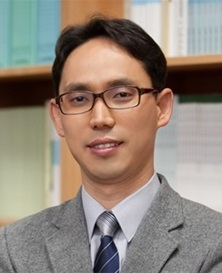- About Ajou
- Admission
- Academics
- Research
-
International
International
- Campus Life
-
News and Event
News and Event
- AUT
Major Research Result
NEW Prof. Seo Hyung-tak’s Team Develops Environment-Adaptable Photosensor Simulating Human Vision
- 2020-12-28
- 5599

A team of researchers including Ajou University’s Prof. Seo Hyung-tak has successfully developed an integrated optoelectronic diode capable of adapting, in a fashion similar to human visual perception, to various environments. The team’s discovery is expected to help develop visual devices with artificial nerves, intelligent photosensors, data processors, and innovations in robotics.
Prof. Seo (Dept. of Materials Science and Engineering / Graduate Dept. of Energy Systems, pictured) has announced that his team has developed a photosensor diode capable of differentiating information processing depending on angles of perception. The team’s invention is discussed in detail in “Environment-Adaptable Photonic-Electronic Coupled Angular Perception System,” published in the October issue of ACS Nano (IF = 14.588). The team included two other members from Ajou: Prof. Kim Sang-wan (Dept. of Electrical and Computer Engineering) and Dr. Mohit Kumar (lead author).
The human vision system is capable of adapting on its own to changes in its surroundings, including differences in lighting, by detecting changes in optic signals in real time. It is also capable of differentiating between visual signals from different angles of vision (up or down, left or right) and processing the obtained data accordingly. Human vision captures optical data and converts it into photoelectronic signals, which are then encoded into electric spikes of appropriate sizes. Information thus processed is then transmitted to the visual cortex and stored on the synaptic network.
Numerous attempts have been made so far to develop artificial sight by simulating the complex and intricate workings of human visual perception. Success has been elusive so far, however, in developing artificial vision with a sufficiently simple structure and a rational energy demand.
Much of the research on artificial sight circuits to date has focused on understanding and visualizing information under general lighting. Effective artificial sight, however, crucially requires a technology capable of recognizing objects from wide viewing angles. Only on the basis of angular perception can researchers proceed to develop an effective and simple humanoid photoelectronic circuit capable of replacing the excessively complex circuits that exist today. Moreover, simplifying these complex circuits requires memory storage capable of adapting automatically to diverse environments.
Prof. Seo’s team has created a photosensitive semiconductor capable of adapting to changing environments and simulating the human nervous system by first creating a quality titanium dioxide (TiOs) nanofilm and then evenly arranging a silver nanowire on it. The silver nanowire (NW) maximizes the photoelectronic effect on angular visual perception, enabling the semiconductor to perceive and process visual data across a wide angle (± 70º). The Schottky-style combination of the silver nanowire and titanium dioxide also ensures the effective collection of photoelectrons to enhance sensitivity to photonic (ultraviolet) signals. This diode structure is simple, yet effectively simulates human visual perception.
Using a 3x3 array, Prof. Seo’s team has created a visual perception diode whose circuit can itself recognize objects in diverse environments. The team has thus discovered that, even for the same given patterns of optic signals, the intensity and duration of memory of those signals vary depending on the given visual angles, the intensity of given light, and the duration and intervals of optic signals. The team, in other words, has demonstrated that their semiconductor is capable of working in much the same manner as the human visual nerves and cortex, and that the mechanism of their neuromorphic optic signal storage is based on the accumulation and loss of electric charges, due to photoelectric combination, on their Schottky diode.
This means that the time it takes for memory stored in the titanium dioxide semiconductor to disappear varies depending on differences in the amounts of light absorbed by the semiconductor because those differences in lighting mean the creation of different amounts of light-induced charges (electron-hole pairs). With this invention, the same in-vivo memory-oblivion system can be added to the memory used to sense and store images on devices such as smartphones.
Prof. Seo commented, “Artificial sight diodes require many component technologies. Our recent study is significant in that it demonstrates how a transparent semiconductor, capable of adapting to changes in environments and detecting and processing optic signals with relatively little energy, can be created.”
He also expects the new diode to “have a wide variety of applications, including intelligent photosensors, data processing, and robotics.”
The study has been made possible thanks to support from the Future New Material and Original Technology Development Program and the Basic Research Support Program for Experienced Basic Researchers, co-organized by the Ministry of Science and ICT and the National Research Foundation of Korea.
